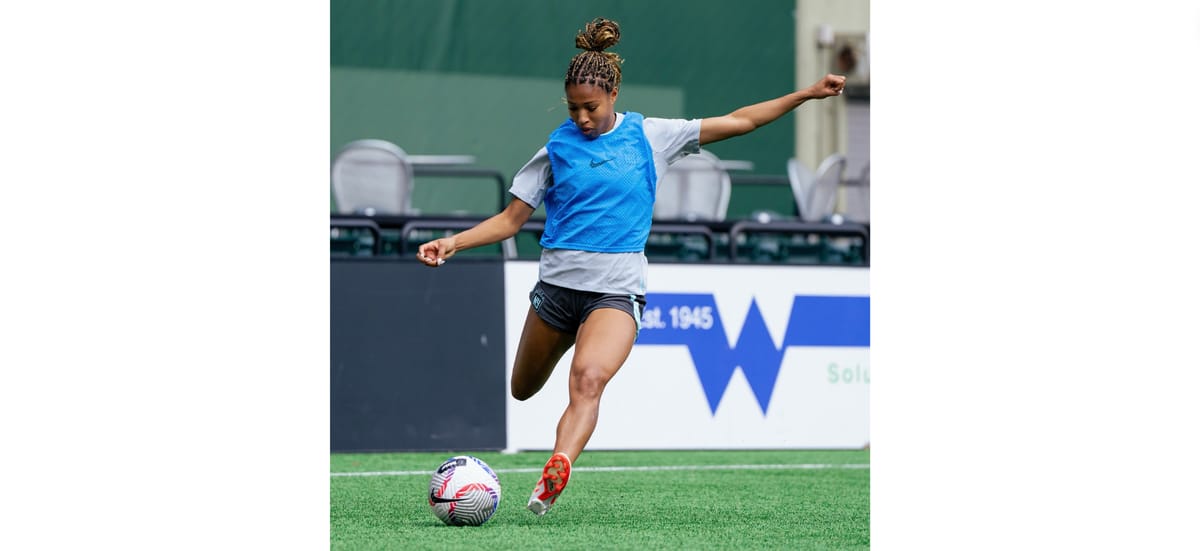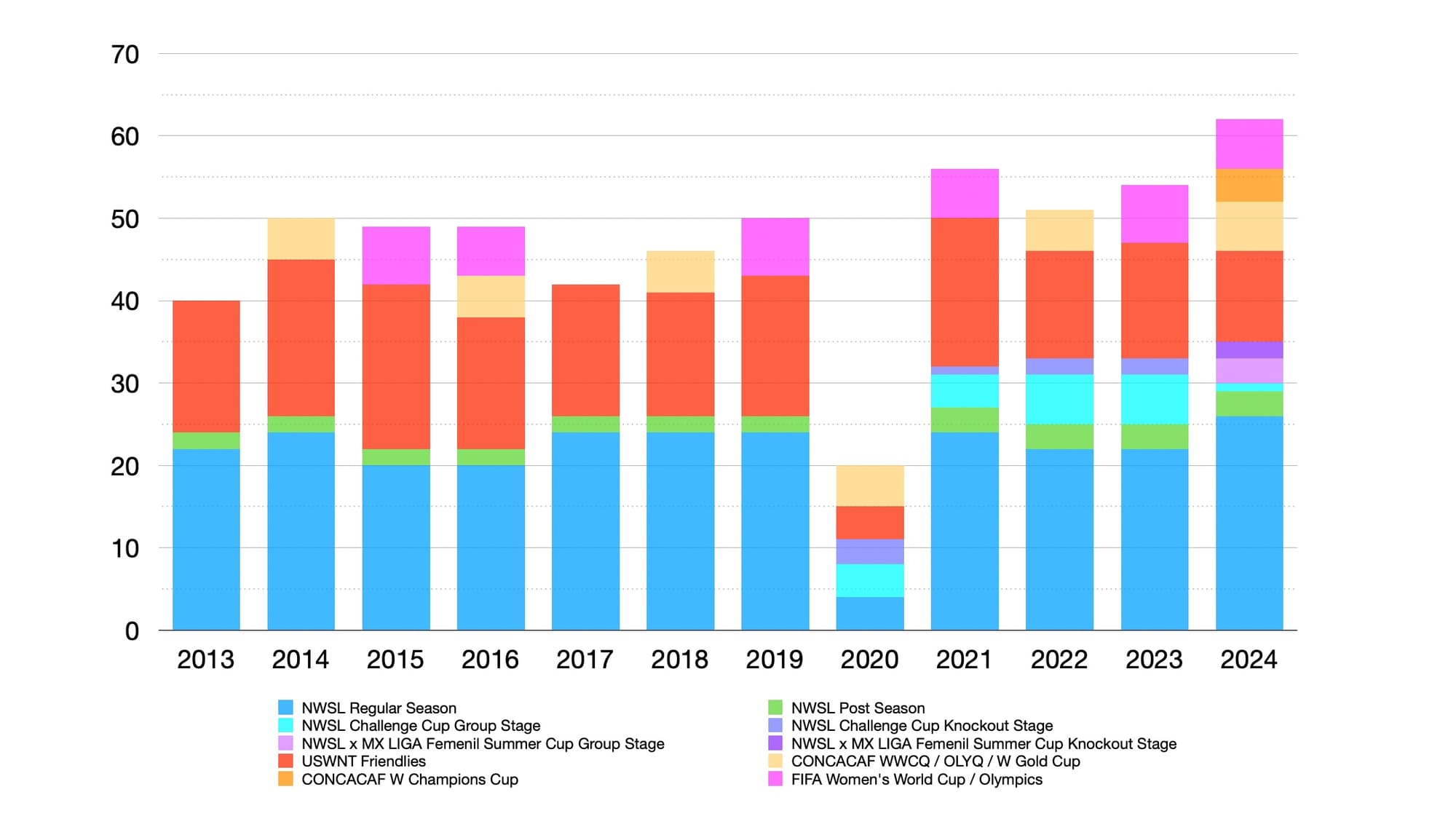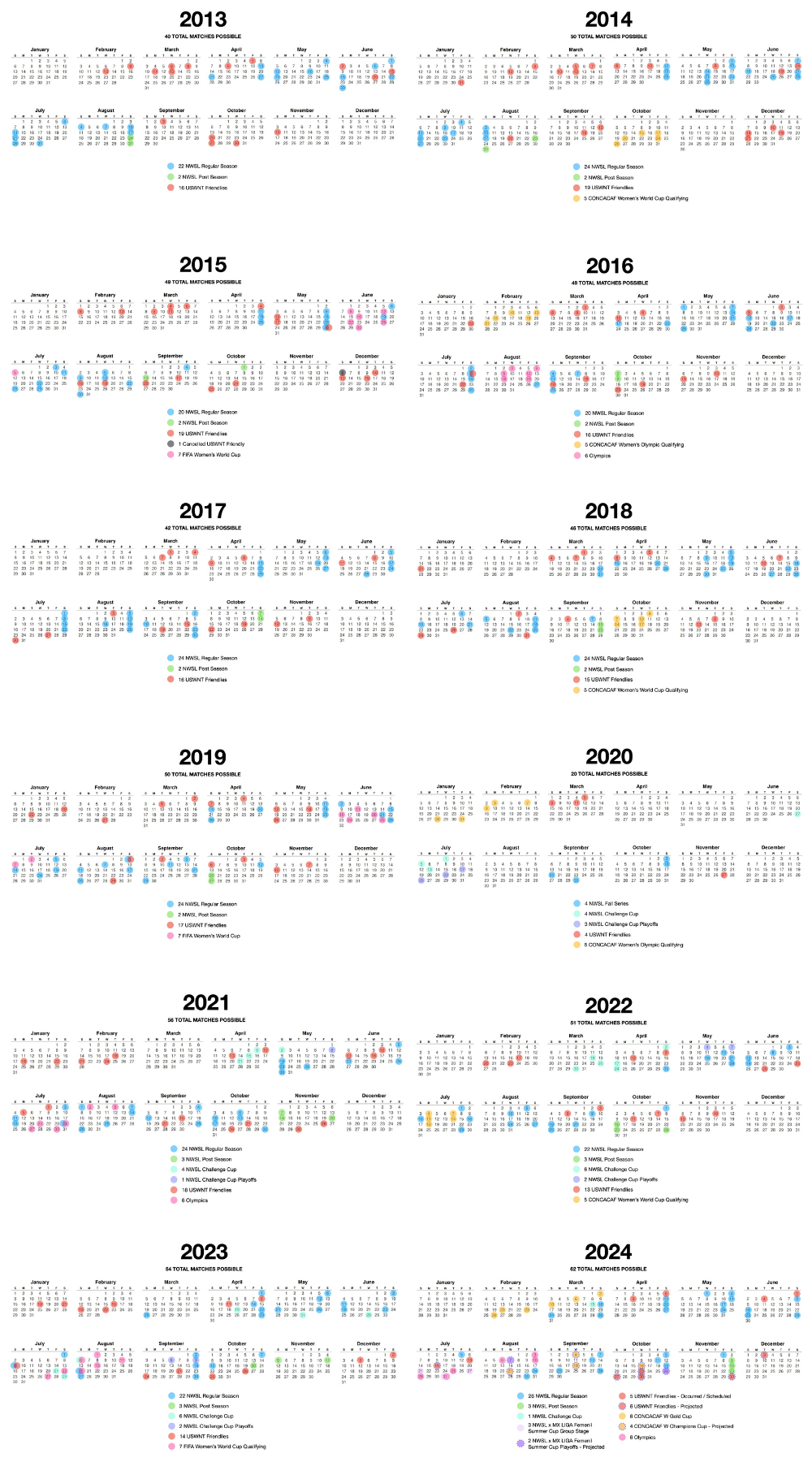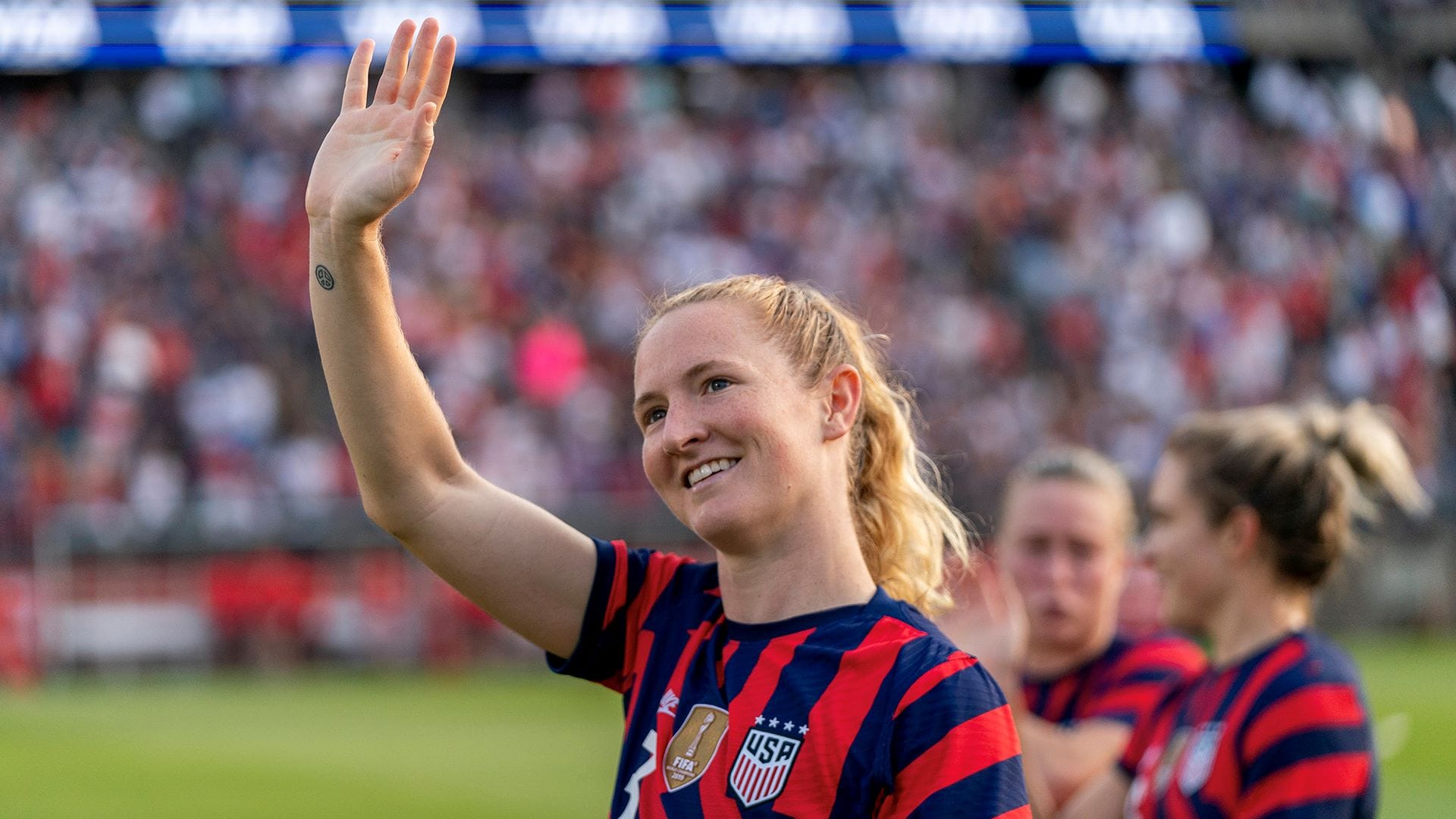Unpacking the women's soccer competition calendar
With player injuries on the rise and rest time on the decline, the women's soccer competition calendar is coming under the crosshairs. How does the competition calendar work, what is leading to more scheduling congestion and what optimizations can be made to improve player health and safety?

In the past month, two things happened within women’s soccer that at their root speak to the same issue.
First, the NWSL announced details for the tournament it will conduct during a mid-summer break from league play so its top players can compete in the 2024 Olympics. The NWSL x LIGA MX Femenil Summer Cup, featuring all 14 NWSL clubs and the six clubs with the most points earned in LIGA MX Femenil Clausura and Aperture during 2023, kicks off with group play July 19-Aug. 2 with four teams advancing to the semifinals the week of Aug. 4. The final will take place the weekend of Oct. 25-27.
Second, three players who played for their countries in the CONCACAF W Gold Cup have seen the start of their NWSL season hampered by injuries while a fourth player saw her NWSL & U.S. Women's National Team (USWNT) seasons already come to an end.
Brazilian forward Debinha only logged the first 32 minutes of the Kansas City Current’s opening match before exiting with a hamstring injury that still has her out. Meanwhile, NJ/NY Gotham FC defeated Portland Thorns FC, 1-0, in their first match of the NWSL regular season on March 24 despite being without midfielder Rose Lavelle (lower leg) and forward Lynn Williams (thigh), who both have yet to appear for Gotham this year. Gotham also lost attacker Midge Purce, who tore her left ACL, just before halftime against the Thorns. Purce will miss the rest of the NWSL season as well as a potential spot on the USWNT Olympic roster.
Gotham FC head coach Juan Carlos Amorós had this to say following Purce’s injury:
“We’re talking about protecting the players, [who shouldn’t] go to play an international competition after one week of preseason. We’ve seen the consequences now. We’ve got Rose, Lynn, last week it was Debinha in Kansas [City] and now we have Midge. From my experience, the clubs are going to keep paying for that competition.”
Amorós added that these injuries are a consequence “of a tournament that shouldn’t have happened.”
So what is the common theme these events share?
The competition calendar, which is becoming more congested as the women’s game grows.
As the sport’s governing bodies seek to drive revenue growth (which also nets players and coaches more money), the ripple effects of a more crowded competition calendar are becoming more noticeable as player workload and injuries increase and player rest and recovery time decreases.
To understand why the congestion is increasing, let’s break down how the competition calendar works and the impact its growth has on players. Then let’s consider some ideas to lessen the congestion and the resulting player workload.
Who schedules matches and puts them on the competition calendar?
Four entities schedule matches which can end up on a professional soccer player’s calendar:
- The league in which their club plays - For example, the NWSL in the U.S., England’s Women’s Super League or France’s Division 1 Féminine.
- The federation which represents their country - For example, U.S. Soccer Federation, the English Football Association or the French Football Federation.
- The confederation which governs soccer in each of six continents - For example, the Confederation of North, Central America & Caribbean Association Football (CONCACAF) or the Union of European Football Associations (UEFA).
- The international federation which governs soccer globally - Fédération Internationale de Football Association (FIFA).
Tell me more about how each entity schedules matches starting with the league.
From a U.S. centric lens, the NWSL is charged with scheduling its league season as well as any other competitions organized by the league … but the NWSL must adhere to the schedule parameters negotiated into the collective bargaining agreement (CBA) by the NWSL Players Association (NWSLPA) in doing so. For the term of the CBA from 2022 - 2026, those parameters are:
- NWSL clubs may play no more than 38 matches (unless agreed to by the NWSLPA).
- These 38 matches include:
- The Regular Season
- The Post-Season
- Exhibition matches
- The Challenge Cup
- Any NWSL organized tournament games (i.e. the just announced NWSL x LIGA MX Femenil Summer Cup)
- These 38 matches do NOT include:
- The NWSL All-Star Game (if held)
- Pre-Season exhibition matches
- Scrimmages
- Any FIFA or CONCACAF official club competitions
In 2024, the maximum number of possible matches a NWSL club could play between all competitions is 35 and just two clubs - Challenge Cup participants NJ/NY Gotham FC and San Diego Wave FC - have the opportunity to reach this upper limit. By 2026 with two more expansion clubs set to join the NWSL - a team in Boston and a yet-to-be-announced team, the NWSL will likely contest the maximum number of matches, 38, allowed for in the CBA.
How about a federation? What matches does a federation schedule and how does a federation determine how many matches to schedule?
A federation schedules friendly matches for its country’s national teams. A friendly match is played for its own sake and is not part of a competition or tournament. A federation may also organize and schedule friendly tournaments for its national team to compete in against other countries’ national teams. Additionally, a federation can schedule national club competitions such as a tournament to crown a national club champion.
Let’s look at the U.S. Soccer Federation as an example. As part of U.S. Soccer’s CBA with the U.S. Women’s National Team Players Association (USWNTPA) which runs from 2022 through 2028, U.S. Soccer each year will hold the greater of:
- 13 matches (inclusive of any tournaments organized by U.S. Soccer such as the SheBelieves Cup) or
- The maximum number of matches permitted by the FIFA International Match calendar (a.k.a. FIFA windows) that are not for Official Competitions (i.e. FIFA Women’s World Cup (WWC), the Olympics, CONCACAF WWC or Olympic qualifiers, CONCACAF W Gold Cup, etc.)
What about clubs? U.S. Soccer currently offers a U.S. Open Cup - to crown a club national champion - for only men and not for women. With the USL Super League slated to launch in the U.S. as a Division 1 league this fall, a U.S. Open Cup for women pitting USL Super League and NWSL clubs against each other is a future possibility (pending negotiations between U.S. Soccer, the NWSL, the USL and the involved players).
What is the role of the confederation in scheduling matches?
A confederation’s role is to organize regional competitions for its members - both at the national team and club level - with select tournaments serving as qualifiers for FIFA events at the global level such as the World Cup and Olympics for national teams and a World Club Championship for club teams.
The U.S. is a member of CONCACAF, the Confederation of North, Central America and Caribbean Association Football.
At the national team level, the USWNT participates in the CONCACAF Women’s Championship - a qualifying tournament held every four years for the FIFA Women’s World Cup and sometimes also the Olympics, a CONCACAF Olympics qualifying tournament (if not part of the CONCACAF Women’s Championship) and the CONCACAF W Gold Cup, which held its inaugural edition in 2024. These CONCACAF competitions typically consist of up to five to six matches per national team.
CONCACAF has also announced plans for the inaugural W Champions Cup, a competition where 10 clubs from across the region will vie to be crowned the regional club champion. A to-be-determined number of CONCACAF clubs will qualify from the W Champions Cup for the yet-to-be-announced FIFA Women’s Club World Cup rumored for 2026.
The CONCACAF W Champions Cup field will include three to-be-determined NWSL clubs and will contest its four-match group stage in August - October with semifinals and a final slated for May 2025.
So what does the international federation do?
The international federation organizes and schedules world championship competitions for national teams and clubs. For soccer, the international federation is Fédération Internationale de Football Association (FIFA). FIFA organizes and schedules the FIFA Women’s World Cup every four years with the next one in 2027 (with the host to be announced in May 2024) and the Olympic football tournaments with the next one in Paris at the 2024 Summer Olympics.
At the 2023 Women’s World Cup, the maximum number of matches a country could potentially play was seven (with the USWNT actually playing four due to a Round of 16 exit). At the 2024 Olympics, the maximum number of potential matches is six.
Within soccer, FIFA also sets the international match calendar (a.k.a. FIFA windows) during which club teams around the world must release their players who are called up for national team duty (i.e. when domestic leagues take international breaks). FIFA dictates how many matches may be played in each window and also places confederation (i.e. CONCACAF) competitions on the international match calendar to ensure clubs globally likewise release their national team players for those regional tournaments. The women’s international match calendar is currently only available through 2025 (while the men’s is available through 2030).
Finally, FIFA is aiming to hold an inaugural Women’s Club World Cup in 2026. The number of club teams and the format for the proposed tournament are unknown.
Wow. That sounds like a lot. So the players are just expected to show up and play no matter what for all of these matches?
Short answer: Yes.
Longer answer:
- At the league and federation levels - at least in the U.S., the players have the ability to negotiate in a CBA how many matches they play per year for their NWSL club and for the USWNT. Bear in mind, how many matches the players agree to play influences both their health and their pay.
- At the confederation and international federation levels, the players have much less sway in that collective bargaining agreements are not a thing, but they can and do advocate for themselves in the media and behind the scenes related to these larger events.
- Finally, given the way the system works with multiple entities able to schedule matches, the onus is put on the individual player to advocate for herself and what she needs when it comes to playing vs resting. Sam Mewis, a former USWNT & NWSL player, and Becky Sauerbrunn, the former USWNT captain and a member of the NWSL’s Portland Thorns FC, discussed the calendar congestion and the responsibility it puts on players in a recent Good Vibes FC edition of The Women’s Game podcast. (Minutes 18:05 - 24:30)
How does the competition calendar work out in reality? And how much has it been growing?
Let’s look at this through the lens of the majority of American female professional soccer players - the players who play professionally in the NWSL and who also play for the U.S. Women’s National Team. Let’s start by simply considering how the maximum number of possible matches for these players has increased since the NWSL’s inception in 2013.
Maximum number of possible matches for a NWSL x USWNT player per year

Chart notes:
- One USWNT friendly was cancelled in 2015 due to an unplayable field but is still represented in the count of USWNT friendly matches as the players showed up and trained for this match.
- In the 2016 Olympics and 2023 FIFA Women’s World Cup, the USWNT could have played a maximum of 6 or 7 matches, respectfully, which is displayed in this chart. Due to early exits, the USWNT actually played less than these maximums.
- The number of USWNT friendlies in 2024 is projected based upon FIFA’s international match calendar as U.S. Soccer has not announced the USWNT’s full schedule for 2024.
In analyzing this chart, let’s start with a disclaimer - it is highly unlikely that any player will actually play the maximum number of total possible matches in a year. First, in order to do so, a player’s team - both her NWSL club and the USWNT - must advance through all possible playoff / knockout matches. Second, even if this happened, the player must then actually log appearances in each of these matches.
But the players who compete in the NWSL and who are also in the USWNT player pool must still prepare physically and mentally as if they will play in each of these matches.
As is evident from the chart, the increase in the number of total possible matches for U.S. based female soccer players is real. In the seven years prior to the pandemic, a player was looking at an average of 46.6 possible matches a year. Over the past four years, that number has swelled to an average of 55.8 possible matches a year, an increase on average of 9.2 potential matches.
Where is this increase coming from? Primarily, the NWSL. Since the pandemic and with the popularity of the league growing, the NWSL has introduced:
- Competitions outside of the regular season such as the Challenge Cup and the NWSL x LIGA MX Femenil Summer Cup accounting for an additional 5-8 potential matches per year.
- An additional knockout round in the post-season increasing a club’s potential number of post-season matches from two to three.
With the addition of expansion sides Bay FC and Utah Royals FC, the 2024 NWSL regular season also increased to an all-time high of 26 matches.
Finally, the possibility of CONCACAF launching a regional club competition in 2024 is contributing to the competition calendar for a U.S. based female professional player exceeding 60 possible matches for the first time ever.
How does this increase in total possible matches impact players throughout the year?
To dive into this question, lets look at the shape of the competition calendar - again for a professional player based solely in the U.S. - and how it has changed year over year since the NWSL’s inception in 2013.
Shape of the competition calendar for a NWSL x USWNT player per year

Chart Notes:
- For all NWSL related matches, I plotted Portland Thorns FC’s match dates as the Thorns are an original NWSL club and have played every home match at the same stadium.
- The USWNT’s full friendly schedule for 2024 has yet to be announced. I projected it based upon the remaining FIFA windows.
- Dates for group play of the 2024 CONCACAF W Champions Cup have not yet been announced. I projected them based upon CONCACAF’s stated competition format and intention to hold these group play matches in August - October.
My takeaways from plotting these annual competition calendars:
- The average length of the NWSL season - inclusive of all competitions - has been on the increase from ~5 months in 2013-2014, to ~6 months in 2015-2016, to ~6.5 months in 2017-2019, to now ~8 months in 2021-2024.
- While the length of the NWSL season has grown, the amount of time between matches could still be improved. Due to more clubs joining the league and more competitions being scheduled (i.e. the Challenge Cup, the Summer Cup), there are still stretches where teams are playing a high number of matches in a condensed timeframe. In plotting the Thorns’ schedule across all NWSL competitions year over year, here is what the congestion looks like in recent years for the Thorns:
- 2024: 3 matches in 8 days
- 2023: 4 matches in 14 days (twice)
- 2022: 4 matches in 14 days
- 2021: 4 matches in 12 days and another span of 4 matches in 14 days
- With the length of the NWSL season increasing, the NWSL season and the USWNT’s schedule are bleeding into one another more and more:
- Prior to 2019, the NWSL season concluded before the USWNT’s matches in October. Now the USWNT’s October matches fall somewhere in-between the end of the NWSL regular season and the completion of the NWSL post-season putting more demand on players competing for the USWNT whose clubs are also championship contenders.
- With the NWSL season now regularly starting in March, the NWSL pre-season - which in accordance with the CBA can be 5-8 weeks in length - is now regularly overlapping with FIFA’s February window during which the 2024 CONCACAF W Gold Cup was held. From 2016-2023, U.S. Soccer organized the SheBelieves Cup during February or early March also overlapping with the NWSL pre-season. Competing in USWNT matches with a trophy on the line while you are in pre-season for both your club and also the USWNT - as USWNT players get a CBA guaranteed 6 weeks off following the November/December FIFA window - puts player health at risk despite the best efforts of coaches to manage minutes.
So what could be done to make the competition calendar less congested and/or the impact on player workload less?
Some ideas at different levels of the game:
- Adjust the Olympics. Today to win a medal, a team with a roster of just 18 players must play 6 matches in 17 days. To lessen the workload, expand rosters to 23 players - the same size as at the FIFA Women’s World Cup. Also consider making the tournament a U-23 competition like the men’s football tournament at the Olympics. (Imagine a U.S. team at the Paris Olympics featuring Trinity Rodman, Jaedyn Shaw, Olivia Moultrie, Alyssa Thompson, Gisele Thompson, Lily Yohannes, Korbin Albert, Eva Gaetino, Ally Sentnor, etc.)
- Tighten the coordination between CONCACAF and the women’s professional leagues in the region, including the NWSL. For example when the NWSL created its 2024 schedule, it was unaware of CONCACAF’s plan to hold the group stage of the W Champions Cup in August - October and therefore did not factor this in to the league calendar. Better communication and collaboration is needed between these entities to grow the game and to protect player health.
- The NWSL is slated to expand to 16 clubs in 2026. Whether it’s 2026 or when the league eventually grows to 18 clubs, the league needs to consider moving to a divisional format for its regular season. In 2026, the obvious choice will be between either playing a 30-match regular season with a home-and-away match against every other club or splitting into two divisions of 8 clubs apiece playing a total of 22 regular season matches (14 total home-and-away matches against the other seven in-division clubs and eight total matches against the eight clubs in the other division with home field advantage rotating every other year). Some factors which will influence this decision include the desired length of the post-season and how the NWSL wants to continue to invest in the Challenge Cup and/or Summer Cup.
- Regarding frequency of matches, currently the CBA between the NWSL and the NWSL Players Association (NWSLPA) calls for the league not to schedule a club to play more than two matches in a seven-day period unless the matches are at least 48 hours apart. When the CBA expires following the 2026 season, consider negotiating an expansion of this timeframe to 72 hours or even 96 hours.
- In the 2024 regular season, three clubs play matches that kick off exactly 72 hours apart: Angel City FC, Portland Thorns FC and Seattle Reign FC.
- In the 2024 regular season, 10 of the NWSL’s 14 clubs play matches that kick off between 72 - 96 hours apart with three clubs doing so twice in the span of eight days:
- Houston Dash: May 5, 8 & 12
- Kansas City Current: May 5, 8 & 12
- San Diego Wave FC: June 15, 19, & 22
- The CBA between U.S. Soccer and the USWNTPA has no clause addressing the frequency of matches for U.S. Soccer friendlies (including the SheBelieves Cup). Granted that scheduling USWNT friendlies is trickier as they must fall within FIFA windows and players must travel to/from their clubs, still consider adding a similar mandate that matches cannot be played within 72 hours of each other when the CBA expires at the end of 2028. When was the most recent occurrence of the USWNT playing two matches within less than 72 hours of each other? A friendly series against Colombia on Oct. 26, 2023 (6:07pm PST kickoff) and Oct. 29, 2023 (2:37pm PST kickoff).
- For players who compete both for the USWNT as well as their club, the onus is currently on them to manage their health and to influence their minutes between the two teams. With more and more money being invested in the game, someone beyond the player herself needs to advocate for the player. Either U.S. Soccer and the NWSL need to jointly hire and empower a Player Safety / Sports Science team to monitor and advocate for the health of these players or as the players earn more money, they should hire their own personal trainer to do so.
Things I ponder…
- Who will backfill NWSL rosters when international players head to Paris to compete in the 2024 Olympics while their NWSL clubs contest the group stage and the semifinals of the NWSL x LIGA MX Femenil Summer Cup during mid-July and early August? The choices are going to be slimmer for NWSL clubs due to the launch of the eight-club USL Super League whose players should be in pre-season at that time.
- The NWSL x LIGA MX Femenil Summer Cup championship match, which in contrast to its name will take place in the fall during the weekend of October 25-27, lands during the middle of a FIFA window. As the group play stage and the semifinals will be contested without any of the involved clubs having their national team players available, having the final played without them on hand seems fitting. But does the final lose some luster?
Trivia Question Answer

In 2017, midfielder Sam Mewis appeared in all 26 NWSL matches, starting 25, as the North Carolina Courage fell to Portland Thorns FC, 1-0, in the NWSL Championship match. Mewis also started all 16 USWNT matches in 2017 making her the only U.S. based player to play all possible matches (42) on the competition calendar during a single calendar year during the 2013-2023 timeframe.
